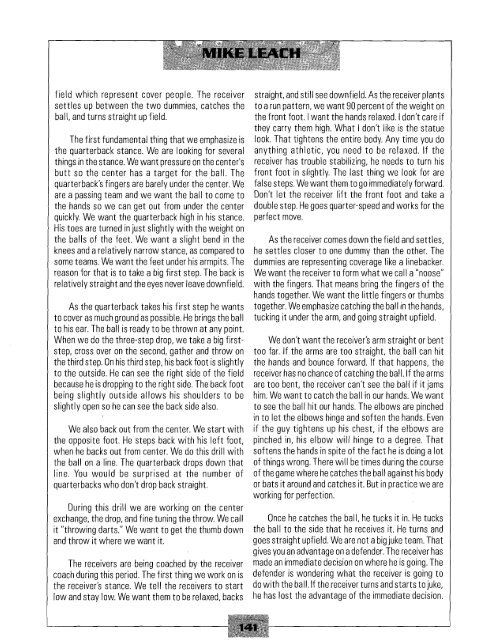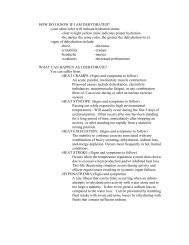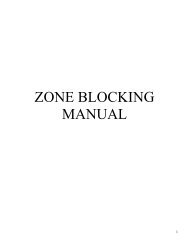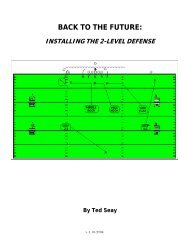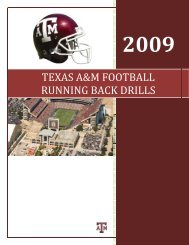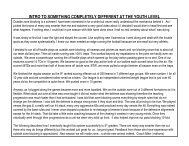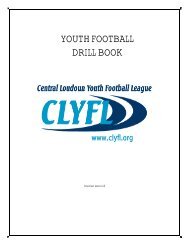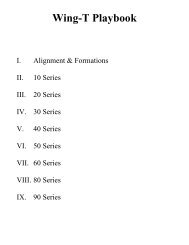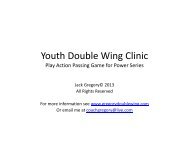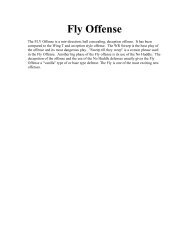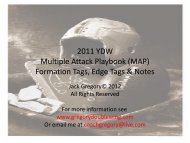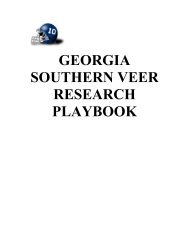Receiver Techniques and Drills - Mike Leach - Gregory Double Wing
Receiver Techniques and Drills - Mike Leach - Gregory Double Wing
Receiver Techniques and Drills - Mike Leach - Gregory Double Wing
Create successful ePaper yourself
Turn your PDF publications into a flip-book with our unique Google optimized e-Paper software.
-field which represent cover people. The receiversettles up between the two dummies, catches theball, <strong>and</strong> turns straight up field.The first fundamental thing that we emphasize isthe quarterback stance. We are looking for severalthings in the stance. We want pressure on the center'sbutt so the center has a target for the ball. Thequarterback's fingers are barely under the center. Weare a passing team <strong>and</strong> we want .the ball to come tothe h<strong>and</strong>s so we can get out from under the centerquickly. We want the quarterback high in his stance.His toes are turned in just slightly with the weight onthe balls of the feet. We want a slight bend in theknees <strong>and</strong> a relatively narrow stance, as compared tosome teams. We want the feet under I- is armpits. Thereason for that is to take a big first step. The back isrelatively straight <strong>and</strong> the eyes never leave downfield.As the quarterback takes his first step he wantsto cover as much ground as possible. He brings the ballto his ear. The ball is ready to be thrown at any point.When we do the three-step drop, we take a big firststep,cross over on the second, gather <strong>and</strong> throw onthe third step. On his third step, his back foot is slightlyto the outside. He can see the right side of the fieldbecause he is dropping to the right side. The back footbeing slightly outside allows his shoulders to beslightly open so he can see the back side also.We also back out from the center. We start withthe opposite foot. He steps back with his left foot,when he backs out from center. We do this drill withthe ball on a line. The quarterback drops down -thatline. You wouldbe surprised at the number ofquarterbacks who don't drop back straight.During this drill we are working on the centerexchange, the drop, <strong>and</strong> fine t1.1ning the throw. We callit "throwing darts." We want to get the thumb down<strong>and</strong> throw it where we want it.The receivers are being coached by the receivercoach during this period. The first thing we work on isthe receiver's stance. We tell the receivers to startlow <strong>and</strong> stay low. We want them to be relaxed, backsstraight, <strong>and</strong> still see downfield. As the receiver plantsto a run pattern, we want 90 percent of the weight onthe front foot. I want the h<strong>and</strong>s relaxed. I don't care ifthey carry them high. What I don't like is the statuelook. That .tightens the entire body. Any time you doanything athletic, you need to be relaxed. If thereceiver has trouble stabilizing, he needs to turr~ hisfront foot in slightly. The last thing we look for arefalse steps. We want them togo immediately forward.Don't let the receiver lift the front foot <strong>and</strong> take adouble step. He goes quarter-speed <strong>and</strong> works for theperfect move.As the receiver comes down the field <strong>and</strong> settles,he settles closer to one dummy than the other. Thedl~mmies are representing coverage like a linebacker.We want the receiver to form what we call a "noose"with the fingers. That means bring the fingers of theh<strong>and</strong>s together. We want the little fingers or thumbstogether. We emphasize catching the ball in the h<strong>and</strong>s,tucking it under the arm, <strong>and</strong> going straight upfield.We don't want the receiver's arm straight or benttoo far. If the arms are too s-traight, the ball can hitthe h<strong>and</strong>s <strong>and</strong> bounce forward. If that happens, -thereceiver has no chance of catching the ball. If the armsare too bent, the receiver can't see the ball if it jamshim. We want to catch the ball in our h<strong>and</strong>s. We wantto see the ball I-~it our h<strong>and</strong>s. The elbows are pinchedin to let the elbows hinge <strong>and</strong> soften the h<strong>and</strong>s. Evenif the guy tightens up his chest, if the elbows arepinched in, his elbow will hinge to a degree. Thatsoftens the h<strong>and</strong>s in spite of the fact he is doing a lotof -things wrong. There will be times during the courseof thegame where he catchesthe ball against his bodyor bats it around <strong>and</strong> catches it. But in practice we areworking for perfection.Once he catches the ball, he tucks it in. He tucksthe ball to the side that he receives it. He turns <strong>and</strong>goes straight upfield. We are not a big juke team. Thatgives you an advantage on a defender. The receiver hasmade an immediate decision on where he is going. Thedefender is wondering what the receiver is going todo with the ball. If the receiver turns <strong>and</strong> starts tojuke,lie has lost the advantage of the immediate decision.


